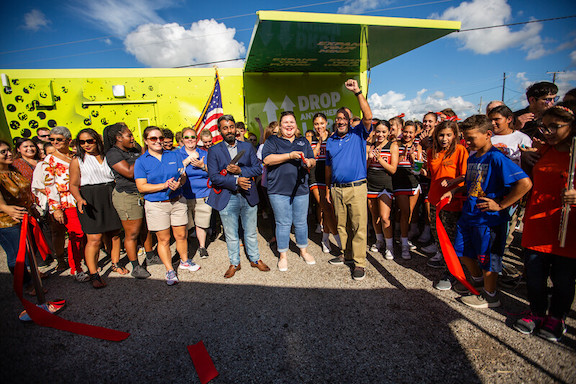Disasters Cause Toxic Stress on Impacted Students
Over the past decade, 620 major natural disasters have been declared in the United States [1]. In 2017, the Texas gulf coast was ravaged by Hurricane Harvey – the most powerful storm to hit Texas in 50 years – which dumped more than 50 inches of rain on communities from Louisiana to Corpus Christi. Nearly three million children were affected by the catastrophic storm, which displaced more than one million people and damaged hundreds of thousands of homes in a path of destruction that stretched 300 miles [2].
The impact on students, schools, and teachers following a natural disaster extends far beyond the initial event into weeks, months and even years of community recovery. New research recently linked student academic performance deficiencies in reading and math up to five years after a disaster event, noting that “without targeted interventions, children’s future academic trajectories, and life opportunities may be compromised” [3].
With limited resources and schools unable to reopen following a natural disaster, many families are left with no options to continue their children’s education and struggle emotionally with the multiple, concurrent stressors of a disaster such as loss of home, movement of friends and/or family, loss of school, uncertainty, and/or material loss. Such stressors contribute to a condition that Harvard University’s Center on the Developing Child has coined “toxic stress,” whereas “[e]xtensive research on the biology of stress now shows that healthy development can be derailed by excessive or prolonged activation of stress response systems in the body and brain.
This kind of prolonged activation of the stress response systems can disrupt the development of brain architecture…and increase the risk for stress-related disease and cognitive impairment, well into the adult years”[4]. A study of school-age children ages 7-13 found that nearly two years following a natural disaster event, 70% of children indicated moderate to severe posttraumatic stress symptomatology including anxiety, depression, withdrawal, and social and attention problems [5].
Such toxic stress can have damaging effects on learning, behavior, and health across students’ lives. Researchers following school-age children impacted by Hurricane Katrina over more than ten years concluded that “[d]isasters may cause students to lose valuable instruction time, and when they fall behind in their academic work they may find it difficult, if not impossible, to catch up. When teachers are overwhelmed, upset and distracted, they may not be able to provide the care and support that are necessary for children’s sense of safety and security within schools” [6].
With no end in sight for the long recovery of these communities and the delayed reopening of schools, students are more likely to fall further behind in their academics and in STEM education. And, while refocusing on school after a disaster is challenging in itself, students face even greater obstacles in STEM subjects, which require more concentration as well as specialized equipment and tools. A 2005 study of disaster-impacted students in Sweden found that “the most negative influence on schoolwork [following a disaster event] was reported for subjects demanding high concentration, e.g mathematics, physics, and grammar” [7].
Our Solution: Mobile STEM Labs for Disaster Recovery
One way to help children reengage with school and create a sense of normalcy is to provide resiliency education programs that can be quickly deployed following a disaster event. Through the use of fully self-sufficient mobile laboratories that travel across the country to those areas impacted, Learning Undefeated has already brought STEM education back to more than 15,000 students across 12 school districts in disaster impacted areas.
With the country’s first STEM-focused education recovery program Learning Undefeated has served more than 30 distinct communities along Hurricane Harvey’s path, from Corpus Christi along the gulf bend and East to the Louisiana border. The lab has served some of the hardest-hit areas of the state, helping students and teachers re-engage with STEM education even in locations where schools are not yet open.
Learning Undefeated’s disaster recovery education program emphasizes engaging, hands-on STEM learning experiences designed to help students re-engage with learning during a time when disaster-related stresses could otherwise distract. Key tenets of the program include:
- Full self-contained STEM education mobile unit – fuel, water, etc., etc.
- Trained staff to support school-based staff and local community leaders
- Authentic, hands-on laboratory learning experiences
- Engaging subject matter tied to real-world careers
- Near-peer mentorship model, providing STEM role models from within the students’ communities
- Emergency power and charging stations
The program also trains and empowers teachers to operate and run the lab, allowing them to teach their own curriculum — catching up their students from many months without a working laboratory space, and allowing teachers to meet state educational requirements for in-laboratory time.
Program Impact to Date
Following the Hurricane Harvey disaster recovery program, Learning Undefeated surveyed teachers in three school districts, representing 3,850 students served by the mobile laboratory during the disaster education recovery period of November 2017 – February 2019. Teachers reported the following outcomes.
- 100% of teachers reported that the Learning Undefeated mobile laboratory provided vital equipment and/or supplies that they could not access due to damage to their school and/or classroom.
- 100% of teachers reported that the Learning Undefeated mobile laboratory increased their students’ ability to focus on learning during a difficult time.
- 100% of teachers reported that the Learning Undefeated mobile laboratory visit allowed them to teach content that would have otherwise been omitted or skipped.
- 75% of teachers reported that the Learning Undefeated mobile laboratory allowed their students to achieve the course requirements for laboratory learning.
- 67% of teachers reported that their students would have missed out on laboratory learning without the Learning Undefeated mobile laboratory coming to their school.
Federal, state, and local government along with leading corporate citizens can work together to facilitate such programs across the country in response to disasters and/or the need to reach certain communities otherwise lacking state-of-the-art STEM education.
Using the Learning Undefeated model, we can help youth in disaster-impacted communities alleviate the toxic stress they are experiencing by helping them reengage with school and ensuring that these students will not fall behind in their STEM learning.














